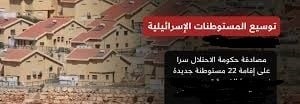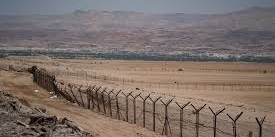By: Madeeha Al-A’raj
The National Bureau for defending land and resisting settlements ( nbprs ) stated in its latest weekly report , that last May, at the initiative of the Settlement Movement “Nahala,” and with funding, logistic assistance, participation of the occupation army, and the support of the so-called “Shomron Regional Council”, settlers built a settlement outpost called “Avitar” on the lands of Beita, Qabalan, and Yatma, on “Jabal Sabeeh,” which prompted the Palestinian citizens there to go out in protest demonstrations against this settlement outpost that resulted in the killing of 4 martyrs so far, by Israeli army fire, including 2 children, and hundreds were wounded, worth mentioning that the Beita’s protests have been ongoing for weeks now.
The area of the outpost in its current situation confiscated dozens of dunams, but the organizers are planning to seize lands estimated at 600 dunams, where 42 families live there. The outpost was built 1.6 km to the east of Za’tara Junction. On its Facebook account, the settlers wrote that it was built to prevent communication between the 3 villages, Qabalan, Yatma, and Beita, and to create a geographical link between the “Taffouh” settlements, west of Za’tara Junction, and the “Migdalim” settlement, located 9 km southeast of the junction on the Jordan Valley’s road.
At the same time, the Civil Administration is pushing for a road construction project near the “Betar Illit” settlement, affecting agricultural lands belonging to the village of Wadi Fukin in the Bethlehem Governorate. The new road plan is currently under approval at the Civil Administration’s Main Planning Office. Its length is 8 km and will connect the Beitar Illit settlement with a road south of it, leading to the Gush Etzion settlement. This road would form a longitudinal axis parallel to the Tunnels Street that connect Gush Etzion with Jerusalem. In the vicinity of Beitar Illit, the occupation government has allocated an area for the establishment of another settlement called “Giva’ot.” There is now a small settlement in the area. To the west of the area, an outpost was designated for the establishment of a future settlement, bearing the name “Givaot”. It is clear that there is no need for this street, but it seems that it is related to preparing for the construction of the new settlement ‘Givat’”
As for planning for settlement construction, the Civil Administration’s Settlement Subcommittee has approved a number of construction projects in settlements in the West Bank, the first projects to be officially approved during the era of the new Israeli government, headed by Naftali Bennett, which included building schools and synagogues, and building A commercial complex, as well as new housing units in the settlement of “Yitzhar.” The construction of a school for children with special needs in the “Elkana” settlement, a commercial complex in the “Mishor Adumim” settlement, and biblical religious institutes and synagogues in the settlements of “Karni Shomron” and “Karni Shomron” were also approved. Kfar Adumim.” Building housing units in “Yitzhar” settlement, and other settlement sites where locations were not announced, was approved, while the occupation authorities deposited a large plan to expand “Svut Rachel” settlement, by adding 534 new settlement units, at the expense of the lands of the residents of each villages of Qariot, Jalud and Turmusaya, halfway between Nablus and Ramallah.
With regard to the flags march in occupied Jerusalem, settlers’ organizations also called for marches throughout the occupied West Bank to demand the new occupation government control Area C, which constitutes more than 60% of the area of the West Bank. Calls were issued for 14 marches from the north of the West Bank to its south, with the support of the settlers’ councils. And the settlers’ call stated that “the Arabs control the area and stifle settlements in a strategic measure that includes intensifying construction work. “We must abandon inaction. We must act.” The text of the call also stated that “we will go out in marches throughout Judea and Samaria (the occupied West Bank) and stop by ourselves the illegal Arab control of the lands.
List of Israeli Assaults over the Last Week Documented by the National Bureau:
Jerusalem:
- Assaulting residents of the Sheikh Jarrah Neighborhood, and attacking the homes of citizens close to the forcibly seized houses there.
- Forcing a Jerusalemite citizen to demolish his own commercial facility in the Al-Sala’a Neighborhood in the Al-Mukaber town, under the pretext of not having a building permit.
- Attacking child Omar Amer Al-Rishq, 6, from the Al-Sa’diya Neighborhood in Jerusalem.
- Forcing a Jerusalemite citizen of demolishing his 3-storey building in the town of Al-Isawiya, otherwise he has to a fine of NIS 400,000.
- Storming the Sheikh Jarrah Nneighborhood and threatening 3 houses with eviction.
Hebron:
- Attacking and throwing stones at the citizens’ homes in the Al-Tawana village in the Masafer Yatta, causing bruises to the disabled elderly Fatima Khalil Rabi’i, 70.
- Demolishing 2 agricultural rooms in Hebron with an area of 120 m2 belonging to Barakat and his brother Naim Abdul Rahman Al-Rajabi, in the Abu Tayah area, southeast of Hebron.
- Storming the Khaliet Harb and Wadi Al-Shumer areas in the western area of the town, and handing notices of stop working on 2 houses.
- Handing notices of removing 2 electricity networks with a length of 3, 500 in the Adana in Hebron, the first with a length of 2,000 meters, serving many inhabited houses since years and tens of dunums of agricultural land, and the second with a length of 1500 meters in the Wadi Al-Shumer in the town.
- Assaulting the driver, Jaber Ali Abed Shatat, and destroying the “Al-Bajer” drilling machine while it was working in the construction of an agricultural road in the Khaliet Al-Daba’ area, east of Yatta, besides cutting wires, and destroying a fuel tank and tires, losses were estimated at NIS 17,000.
Bethlehem:
- Demolishing an agricultural room in the Um Rakba area, south of Al-Khader under the pretext of not having a building permit.
- Handing a stop working notice to an agricultural facility in the village of Wadi Fukin under the pretext of not having a building permit, knowing that the notified facility is a tent used for agricultural purposes adjacent to the “Pinar Illit” settlement, which is located on the lands of citizens in he Husan town, Wadi Fukin, and Nahalin.
- About 100 armed Israeli settlers stormed the archaeological area of Solomon’s Pools, south of Bethlehem, and a high mountain hill overlooking the neighboring village of Artas, area A, under strict Israeli protection.
- Dozens of settlers gathered in 3 locations near the settlement bloc “Efrat” and chanted anti-Palestine slogans in the south of Bethlehem.
- Closing the Al-Quds-Hebron Street, south of Bethlehem.
Ramallah:
- Bulldozing 300 dunums land to build a new settlement road in the Jabal Al-Alam area, north of Ni’lin, which effectively paves the way for the seizure of hundreds of dunams of the town’s lands.
- The detention of the Palestine TV crew in the “Khaliet Malik” area, located between the towns of Deir Qadis and Ni’lin.
- Handing notice to the Citizen Ayman Adnan Sateeh of the demolition of his 4 commercial shops which are under construction, on the other hand, the Israeli High Court approved the demolition of the house of the prisoner Montaser Shalabi, accused of killing a settler at Za’tara Checkpoint 2 months ago.
Nablus:
- Attacking the Palestinian vehicles on the road between the towns of Qusra and Jalud, south of Nablus.
- Preventing the Palestinians from accessing their lands in the town of Qusra.
- Handing demolition notices for 21 homes and a mosque under construction in the Rojeeb village in the areas of “Khilat Al Dahhak” and “Al Saljat” under the pretext of building in Area C without having permits.
- Closing all the secondary roads leading to the Jabal Sbeih with earth mounds to prevent citizens from reaching the settlement outpost.
- Confiscating a bulldozer belonging to the municipality of Beita.
- Opening fire towards the citizen Muhammad Arandas, from the Ein Aboos village south of Nablus, under the pretext of attempting to stab an Israeli settler.
Salfeet:
- Closing the Wadi Qana and preventing the farmers from entering their lands. On the other hand, about 150 settlers were stationed in the Al-Ein area near the main entrance to the valley, in preparation for a provocative march.
- Uprooting olive trees and destroying an irrigation network in the Wadi Qana in addition to burning dozens of fig and olive seedlings in the “Al-Ras” area, west of Salfeet.
Qalqilya:
- Bulldozing 15 dunums of lands of Azzun town near the “Ma’ale Shomron” settlement street in addition to uprooting olive trees from the town’s lands along the settlement street to the east of the town.
 المكتب الوطني للدفاع عن الارض ومقاومة الاستيطان منظمة التحرير الفلسطينية
المكتب الوطني للدفاع عن الارض ومقاومة الاستيطان منظمة التحرير الفلسطينية




